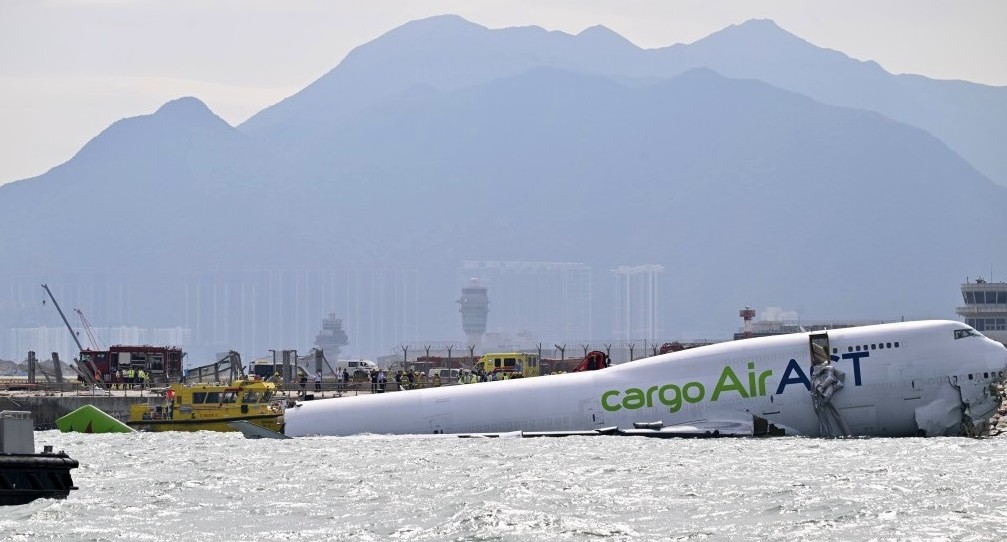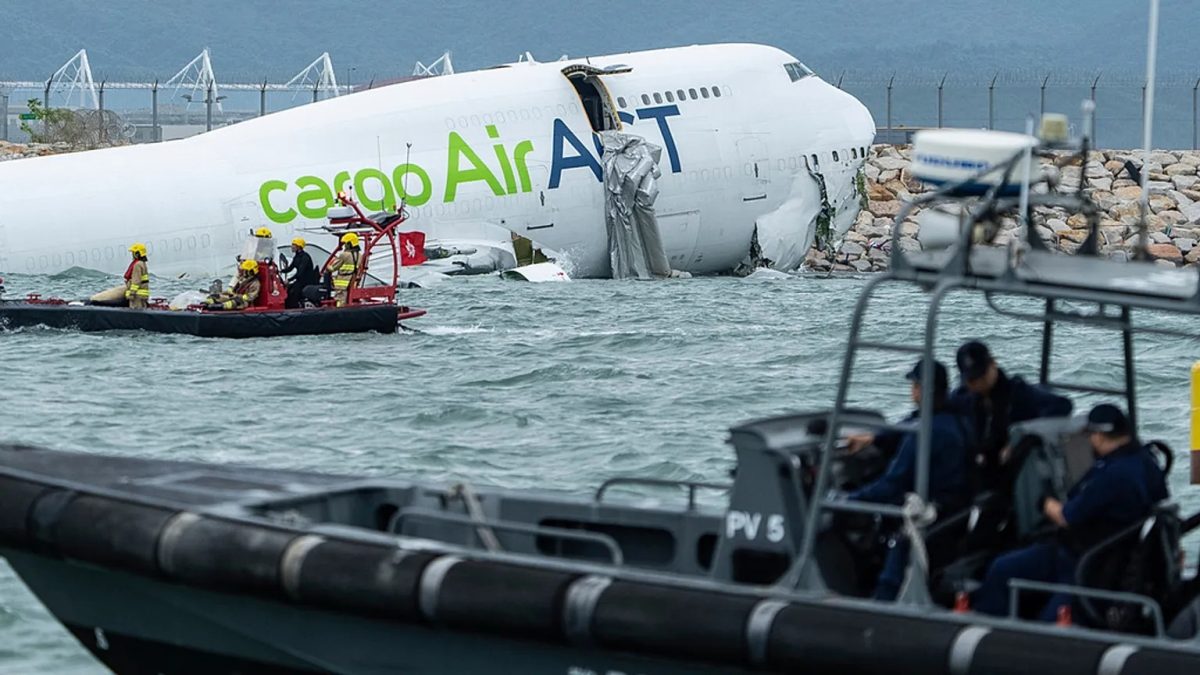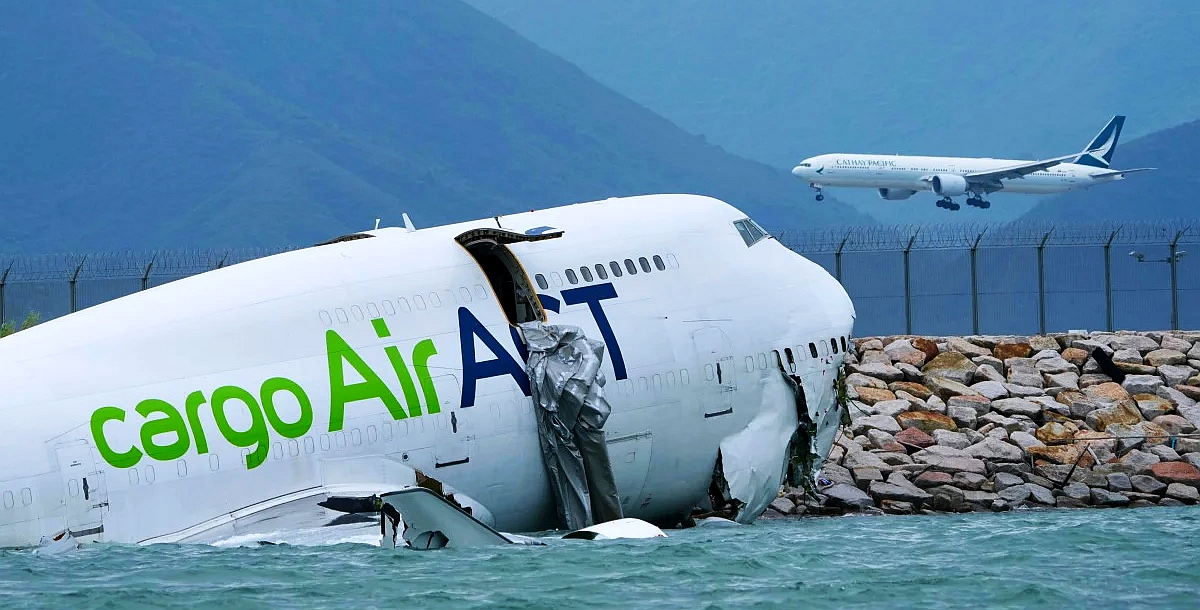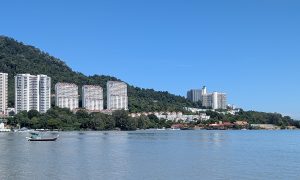A cargo aircraft overshot the runway at Hong Kong International Airport early Monday, crashing into the sea and colliding with a patrol vehicle, leaving two airport staff dead and four crew members injured.
A cargo aircraft operated by Turkish carrier ACT Airlines crashed into the sea at Hong Kong International Airport (HKIA) in the early hours of Monday, killing two airport security personnel after colliding with their patrol vehicle on the runway.
The Boeing 747 freighter had arrived from Dubai and was attempting to land on the airport’s north runway when it skidded off course at around 3:50 a.m. local time, officials confirmed. The aircraft broke in two on impact, with the fuselage resting partially submerged in shallow waters just beyond the tarmac.
“Unfortunately, an airport security patrol car was there at that time,” said Steven Yiu, Executive Director of Airport Operations at HKIA. “The aircraft collided with the patrol car and pushed the car into the sea.” Both occupants of the vehicle were killed instantly, he added.
Numerous reports are saying an ‘Emirates cargo plane'”‘ crashed, which is only partially accurate. Although the flight carried an Emirates SkyCargo designation (EK9788), the 747 aircraft was in fact operated by Turkey-based ACT Airlines under a wet-lease agreement. In such arrangements, the lessor provides both the aircraft and crew, while the lessee (in this case, Emirates) markets the flight under its own brand. Emirates confirmed that the plane was operated by ACT Airlines and that no cargo was on board at the time of the accident.
“We can confirm that the [ACT Airlines] crew are safe and being cared for,” an airport spokesperson said, declining to elaborate on the pilot’s experience or the aircraft’s maintenance history. ACT Airlines has not yet issued an official statement.
AT A GLANCE
- • Emirates flight EK9788, operated by Turkish cargo airline Air ACT, landed on the north runway at Hong Kong International Airport around 03:50 local time (19:50 GMT).
- • The Boeing 747 veered off the runway, crashing through the airport fence and colliding with a patrol car, pushing it into the sea. Two airport security staff, aged 30 and 41, were killed.
- • The aircraft, over 30 years old and converted from a passenger plane to a freighter, broke in half after impact.
- • All four crew members were rescued and hospitalised. Emirates confirmed they are safe and that no cargo was onboard.
- • The flight operated under a wet-lease arrangement, meaning Air ACT supplied the aircraft and crew while Emirates marketed the service.
- • Weather conditions were clear, and officials said the plane received correct landing instructions. No distress signal was sent before the crash.
- • Authorities have launched a full investigation and have not ruled out a criminal probe.
- • This is only the second deadly incident at Hong Kong International Airport since its opening in 1998. In 1999, a China Airlines jet crash-landed during a typhoon, killing three people.
EMERGENCY RESPONSE AND INVESTIGATION
Dramatic video footage showed the plane’s tail section torn away and floating separately from the main fuselage, while emergency crews worked to stabilize the wreckage. More than 200 responders, including firefighters, marine police, and medical teams, were deployed in the rescue and recovery operation.
All four crew members on board were rescued and sent to local hospitals for treatment. Hong Kong’s Civil Aviation Department said none of them suffered life-threatening injuries.
Wesley Yung, Technical Chief of the department, said no distress call or request for assistance had been received before the crash. “We did not receive any indication from the cockpit that there were issues during approach,” Yung said, adding that flight data and cockpit voice recorders have been recovered and handed over for analysis.
The north runway remains closed pending removal of the aircraft, while the airport’s other two runways continue to operate as normal. “We do not expect significant disruptions,” Yiu said, noting that the airport typically handles over 1,000 flights per day.

A RARE FATAL ACCIDENT AT A MAJOR HUB
Fatal aviation incidents are rare at Hong Kong International Airport, one of the world’s busiest air hubs and a critical gateway for cargo in Asia. The airport, located on reclaimed land off Lantau Island, is known for its stringent safety protocols and advanced infrastructure.
The last major accident at the airport occurred in 1999, when a China Airlines flight from Taipei crashed during landing amid strong crosswinds brought by Typhoon Sam. The plane flipped over after touching down, killing at least two people and injuring more than 200.
Before Hong Kong moved its international operations from the cramped Kai Tak Airport in 1998, the city’s aviation scene had long been marked by daring landings. Kai Tak’s single runway extended out into Victoria Harbour, surrounded by tall apartment blocks in Kowloon City, making it one of the world’s most challenging airports for pilots.
QUESTIONS OVER WEATHER AND SAFETY
Investigators are now examining weather data, flight records, and the aerodrome’s ground safety systems to determine what caused Monday’s crash. Early reports indicated clear weather at the time of landing, suggesting that mechanical failure or a navigational error may have played a role.
Aviation experts say that while modern landing systems are designed to prevent runway overruns, factors such as wind shear, hydraulic failure, or pilot misjudgment could still contribute to such an accident.
“This will be a complex investigation,” said Dr. Michael Lam, an aviation analyst based in Singapore. “The fact that the aircraft broke apart suggests a high-speed impact, possibly after overshooting the touchdown point or encountering control difficulties on rollout.”
ACT Airlines, based in Istanbul, operates a fleet of Boeing 747-400 and Airbus A330 cargo aircraft, serving routes across Europe, Asia, and the Middle East. The company, which has previously leased aircraft to major carriers including Turkish Airlines and Qatar Airways, has generally maintained a clean safety record since its founding in 2004.

GLOBAL ATTENTION ON HONG KONG’S AIR SAFETY
The crash comes at a time when Hong Kong’s aviation industry is rebounding from years of pandemic-related slowdown. Air cargo, in particular, plays a vital role in the city’s economy, with HKIA ranking among the world’s top three busiest airfreight hubs.
The Airport Authority Hong Kong (AAHK) has pledged full cooperation with the investigation and expressed condolences to the families of the victims. “Safety remains our top priority,” the authority said in a statement. “We are working closely with local and international agencies to ensure all aspects of this incident are properly reviewed.”
By late Monday, divers had secured the wreckage for recovery, while cranes were being positioned along the breakwater to begin lifting operations. Authorities said it could take several days to remove the damaged plane from the water and restore full runway operations.
As the investigation continues, attention will focus on how a well-maintained aircraft on a routine cargo route could end in tragedy at one of Asia’s most sophisticated airports.
Sources: CNN Asia, Reuters, AP News





















